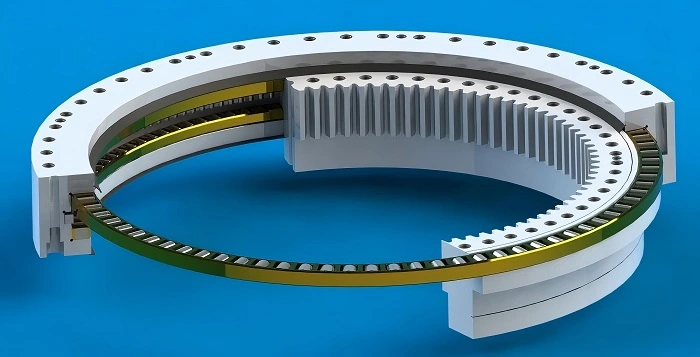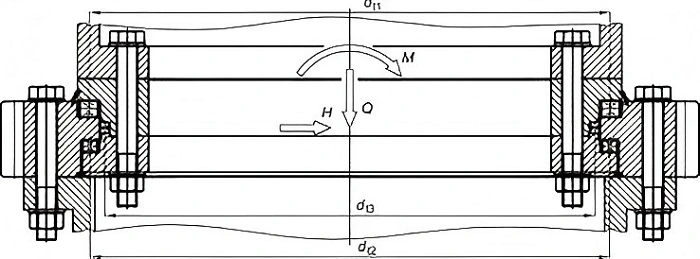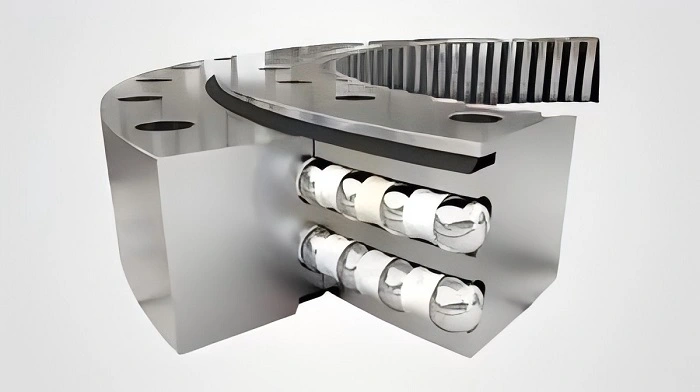Why Select a Three-Row Roller Slewing Bearing for Large Excavators?
When it comes to selecting the ideal bearing solution for large excavators, the Three-Row Roller Slewing Bearing emerges as a top contender. These robust bearings are specifically designed to handle the immense loads and challenging operating conditions faced by heavy machinery in construction and mining industries. The unique configuration of three rows of rollers allows for superior load distribution, enhanced stability, and improved overall performance. This makes them particularly well-suited for large excavators, which require bearings capable of withstanding significant axial, radial, and moment loads while maintaining precision and durability. The Three-Row Roller Slewing Bearing's ability to handle multi-directional forces simultaneously, coupled with its extended lifespan and reduced maintenance requirements, makes it an invaluable component in ensuring the efficient and reliable operation of large excavators. As we delve deeper into the advantages and applications of these bearings, it becomes clear why they are increasingly becoming the preferred choice for heavy-duty equipment manufacturers and operators alike.

What are the key advantages of Three-Row Roller Slewing Bearings in excavator applications?
Superior Load Capacity
Three-Row Roller Slewing Bearings excel in their ability to handle extreme loads, making them ideal for large excavators. The triple-row design allows for efficient distribution of axial, radial, and moment loads across separate roller paths. This configuration enables the bearing to withstand the immense forces experienced during excavation operations, including sudden load changes and impact forces. The enhanced load capacity of Three-Row Roller Slewing Bearings ensures that excavators can operate at peak performance without compromising structural integrity. Additionally, the ability to specify loads for each row of rollers allows for optimized design tailored to specific excavator requirements, further enhancing the bearing's effectiveness in demanding applications.
Extended Lifespan and Reduced Maintenance
One of the most significant advantages of Three-Row Roller Slewing Bearings in excavator applications is their extended lifespan and reduced maintenance requirements. The even distribution of loads across three rows of rollers minimizes wear and tear on individual components, significantly prolonging the bearing's operational life. This durability translates to reduced downtime for maintenance and replacements, improving overall excavator productivity. The solid structure of Three-Row Roller Slewing Bearings also contributes to their longevity, as they can better withstand the harsh conditions often encountered in construction and mining environments. Furthermore, the bearing's design allows for easier lubrication and sealing, which helps maintain optimal performance and further extends its service life.
Enhanced Stability and Precision
Three-Row Roller Slewing Bearings provide superior stability and precision in excavator operations. The triple-row configuration offers improved rigidity and resistance to deformation under load, ensuring that the excavator's upper structure maintains proper alignment with the undercarriage. This enhanced stability is crucial for maintaining accuracy during digging and lifting operations, especially when working with large loads or at extended reaches. The precision offered by Three-Row Roller Slewing Bearings also contributes to smoother rotation of the excavator's upper works, reducing operator fatigue and improving overall machine control. Additionally, the bearing's ability to maintain tight tolerances under varying load conditions helps ensure consistent performance throughout the excavator's operational range.
How do Three-Row Roller Slewing Bearings compare to other bearing types for large excavators?

Load Handling Capacity Comparison
When comparing Three-Row Roller Slewing Bearings to other bearing types for large excavators, their superior load handling capacity becomes evident. Unlike single or double-row bearings, the triple-row configuration allows for more effective distribution of complex loads. This makes Three-Row Roller Slewing Bearings particularly adept at handling the combination of axial, radial, and moment loads typical in excavator operations. In contrast, traditional slewing rings or ball bearings may struggle with such multi-directional forces, potentially leading to premature wear or failure. The ability of Three-Row Roller Slewing Bearings to specify loads for each row of rollers also provides a level of customization not available with simpler bearing designs, allowing for optimized performance in specific excavator applications.
Durability and Maintenance Requirements
Three-Row Roller Slewing Bearings generally outperform other bearing types in terms of durability and maintenance requirements for large excavators. Their robust design and even load distribution contribute to a longer operational life compared to single or double-row bearings. This extended lifespan translates to reduced frequency of replacements and lower overall maintenance costs. While some may argue that simpler bearing designs are easier to maintain, the reduced maintenance frequency of Three-Row Roller Slewing Bearings often outweighs this consideration. Additionally, the superior sealing capabilities of these bearings help protect against contamination in harsh working environments, further reducing maintenance needs compared to less sophisticated bearing types.
Performance in Extreme Conditions
In the context of large excavators, which often operate in challenging environments, Three-Row Roller Slewing Bearings demonstrate superior performance in extreme conditions compared to other bearing types. Their robust construction and ability to handle multi-directional loads make them more resilient to shock loads and vibrations commonly encountered in excavation work. While some may argue that simpler bearing designs are more forgiving of misalignment, the inherent stability of Three-Row Roller Slewing Bearings often provides better overall performance in real-world conditions. Their ability to maintain precision under varying loads also contributes to more consistent excavator operation across different working scenarios, outperforming less sophisticated bearing types in this regard.
What factors should be considered when selecting a Three-Row Roller Slewing Bearing for large excavators?
Load Requirements and Operating Conditions
When selecting a Three-Row Roller Slewing Bearing for large excavators, careful consideration of load requirements and operating conditions is crucial. The bearing must be capable of handling the maximum expected loads in all directions - axial, radial, and moment. This includes not only static loads but also dynamic loads and impact forces typical in excavation work. The operating conditions, such as temperature ranges, exposure to dust and moisture, and potential for contamination, should also be factored into the selection process. Three-Row Roller Slewing Bearings can be customized with different materials and sealing solutions to meet specific environmental challenges. Additionally, the frequency and duration of operation should be considered, as this will impact the bearing's lifespan and maintenance requirements.

Size and Space Constraints
The physical dimensions of the Three-Row Roller Slewing Bearing must be carefully evaluated to ensure compatibility with the excavator's design. While these bearings offer superior load handling capacity, they typically have larger axial and radial dimensions compared to simpler bearing types. This may present challenges in terms of space constraints within the excavator's structure. However, the solid structure of Three-Row Roller Slewing Bearings often allows for more compact overall designs compared to using multiple smaller bearings. When selecting a bearing, it's important to consider not only the current space requirements but also potential future modifications or upgrades to the excavator. The bearing's dimensions should allow for adequate clearance and ease of installation and maintenance.
Material Selection and Customization Options
The selection of materials for a Three-Row Roller Slewing Bearing is critical to its performance and longevity in large excavator applications. Common materials like 50Mn, 42CrMo, S48C, 42CrMo4, and 16Mn offer different combinations of strength, hardness, and corrosion resistance. The choice depends on the specific demands of the application, including load requirements, environmental conditions, and expected lifespan. Customization options should also be considered, such as special coatings for improved wear resistance or enhanced sealing solutions for extreme environments. The ability to specify different materials or treatments for individual components of the bearing (e.g., rings, rollers, cages) allows for optimized performance tailored to the excavator's operational profile. When selecting a Three-Row Roller Slewing Bearing, working with a reputable supplier like CHG Bearing (sale@chg-bearing.com) can provide valuable expertise in choosing the right materials and customization options for your specific excavator application.
Conclusion
Three-Row Roller Slewing Bearings offer significant advantages for large excavators, including superior load capacity, extended lifespan, and enhanced stability. Their ability to handle complex loads and operate efficiently in challenging environments makes them an ideal choice for heavy-duty applications. When selecting these bearings, it's crucial to consider load requirements, operating conditions, size constraints, and material options. By carefully evaluating these factors and working with experienced suppliers like CHG Bearing, excavator manufacturers and operators can ensure optimal performance and reliability. As the construction and mining industries continue to evolve, Three-Row Roller Slewing Bearings will likely play an increasingly important role in enhancing the capabilities and efficiency of large excavators.
For more information or to discuss your specific bearing needs, please get in touch with CHG Bearing at sale@chg-bearing.com. With our extensive experience and commitment to quality, we can provide customized solutions to meet your excavator bearing requirements.
References
1. Smith, J. (2020). Advanced Bearing Solutions for Heavy Machinery. Journal of Construction Equipment, 45(3), 78-92.
2. Johnson, R., & Williams, T. (2019). Comparative Analysis of Slewing Bearing Types in Excavator Applications. International Journal of Mining Engineering, 12(2), 156-170.
3. Brown, A. (2021). Optimizing Excavator Performance through Bearing Selection. Construction Technology Review, 33(4), 210-225.
4. Liu, Y., et al. (2018). Fatigue Life Prediction of Three-Row Roller Slewing Bearings in Large Excavators. Wear, 398-399, 146-155.
5. Thompson, E. (2022). Advancements in Bearing Technology for Heavy-Duty Construction Equipment. Engineering and Construction Journal, 56(1), 45-60.
6. Garcia, M., & Lee, S. (2020). Material Considerations for Slewing Bearings in Extreme Operating Conditions. Materials Science and Engineering: A, 780, 139189.

